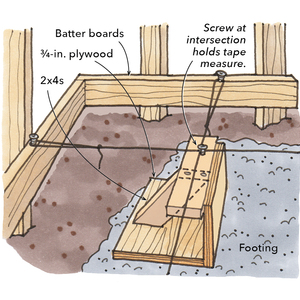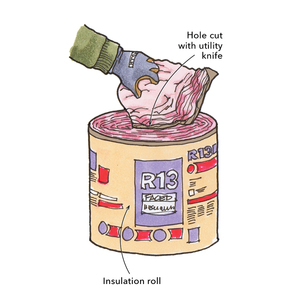I recently purchased a home built in the early to mid 1920’s. It is a 2 story with a gabled “barn style” roof. I had an engineer do an inspection prior to purchase and he discovered that the joists in the second floor ceiling (effectively the “floor” of the attic) run perpendicular to the rafters. He said the joists should be parallel to the rafters to prevent the roof from wanting to move outward under load (ie-snow). He recommended connecting a 2×6 near the bottom of each rafter pair, effectively making a triangle which would stiffen the roof and prevent movement. It doesn’t appear that there have been any problems to date. Is this a major concern? Will his fix work? I don’t want to have to worry about the roof, or my re-sale value.
Discussion Forum
Discussion Forum
Up Next
Video Shorts
Featured Story

The Titan Impact X 440 offers great coverage with minimal overspray.
Featured Video
How to Install Cable Rail Around Wood-Post CornersHighlights
"I have learned so much thanks to the searchable articles on the FHB website. I can confidently say that I expect to be a life-long subscriber." - M.K.
Fine Homebuilding Magazine
- Home Group
- Antique Trader
- Arts & Crafts Homes
- Bank Note Reporter
- Cabin Life
- Cuisine at Home
- Fine Gardening
- Fine Woodworking
- Green Building Advisor
- Garden Gate
- Horticulture
- Keep Craft Alive
- Log Home Living
- Military Trader/Vehicles
- Numismatic News
- Numismaster
- Old Cars Weekly
- Old House Journal
- Period Homes
- Popular Woodworking
- Script
- ShopNotes
- Sports Collectors Digest
- Threads
- Timber Home Living
- Traditional Building
- Woodsmith
- World Coin News
- Writer's Digest


















Replies
Well, it's been there for 80 years. What's held it together so far? Some more details on the construction would probably be helpful.
Pete
I don't know all the proper terms but here goes:
It is stick built timber construction (2x6's and 2x4's,etc) over a full basement. The second story is smaller than the first, when you look at the house end on from outside it kind of has a barn profile- I think this might be called "Dutch Colonial". The rafters come down from the peak of the roof and attach to the perimeter joists. The joists, as I mentioned run parallel to the rafters and therefore the outward load of the roof is not supported along the length of each joist. It doesn't look like there has been much movement of the house as a whole but somewhere along the line someone tacked a few 2x4's perpendicularly from the joists up to the radters in a few spots. Don't know if they had a problem or just realized that the peak of the roof might not be properly supported.Does this help any?
PS- several windows in the home don't open and close properly but they are are old and more than a few are painted shut.
I won't start by bashing engineers because I'm one of 'em. It's a good point to bring up that it's stood up for 80 years. Just because the joists run perpendicular to the rafters is not indicative of a problem in my opinion. I own a 1908 house with a hip roof, which puts outward pressure on all four walls of the house under snow loads. I can assure you that it doesn't have two sets of floor joists (one running in each direction) to counter the outward thrust on the walls. I can also assure you that it's still standing and I live in central New York where we get 200" of snow in some years. All sarcasm aside, I suspect that if you have any sort of floor in the attic (either individual boards or modern day sheathing), that that's giving you a lot of strength. It's also worth saying that my detached garage is also a hip roof and whoever built it years ago didn't include any collar ties (what would be the floor joists in your attic) in either direction. The walls of the garage are pushed out noticeably but it's still standing and I still put all my tools and myself in there every day. I did add a slew of 2x8s to hold everything together.
I think a good way to see if you've really got an issue is to go outside and sight down the walls of the house to see if there's any noticeable bowing of the walls. If you do implement any sort of bracing, I think the general school of thought is to "stabilize" and not try to "correct" unless you've got a serious amount of deflection. What I mean is, add framing to hold the house where it is instead of trying to force it back the way it was. The latter can put a lot of stress on the house and you may find it impossible to correct anyway. I tried to pull the opposing walls of my garage back together with a come-along and no go. The cables started cutting into the framing and the walls didn't budge so I left them where they were and added the 2x8 collar ties. Hope this rambling is useful to you. Good luck.
Edited 3/11/2003 5:25:09 PM ET by stonebm
Collar ties are cheap. Treat yourself, throw some in.
Remember, gravity isn't just a good idea, It's a law.
WAHD
My house (1926) is like that, too -- ceiling joists perpendicular to the rafters. It has 1x6 collar ties every other rafter. Check with your local building department, they may have a handout sheet like ours does that shows how to do simple generic framing. One item on that sheet is how to do collar ties when the ceiling joists for some good reason are running the other way. If you don't have a building department where you are, google the Los Angeles Dept. of Building and Safety, and look at what they call the "Type V Sheet".
-- J.S.
WAHD supplied you with both great humour and good advice, but the argument that eighty years of success outweighs the house inspectors comments is a powerful one.
I wouldn't lopose any sleep over it but if you have a few hours to kill, it won't hurt to throw in some ties.
As for it hurting resale value - the owners who sold it to you got their money, didn't they?
BTW, the house style may be Dutrch Colonial but the roof style is called Gambrel
Excellence is its own reward!
Thanks all for the good info, sounds like this is a fairly common situation (which I guess doesn't surprise me). I'll probably throw in some supports at some point but I've got a long list of more pressing projects first! Thanks again.
If there is a sturctural ridge beam it doesn't matter which way the ceiling joist run.
could you describe a "structural ridge beam" for me?
Thanks
A structural ridge beam would run from gable end to gable end at the peak of the house. All of the top ends of the rafters would be attached to the beam and assentially bear half thier weight upon the beam. A structural ridge beam would be of the proper size to be able to carry the load of the roof + snow load + a few other variables. A 1920's carpenter probably did not do the math to figure for loads; however over building was as common as under building. One benefit to your gambrel style home is that the run of the low pitch section of your roof is shorter than most common gables. Also lower pitched roofs don't have the same outward pushing force of steeply pitched roofs. There is also some triangulation between the steep portion of you roof and the interior wall attached to it that would oppose the outward force. If the structure is sound and hasn't moved, sagged, or otherwise tweeked one way or the other don't mess with it. If it ain't broke don't fix it. If there is substancial sagging call in the engineers.
Thanks, I'll check it out.
> Also lower pitched roofs don't have the same outward pushing force of steeply pitched roofs.
The lower the pitch, the higher the spreading force -- You can get a feel for this just by playing with an ordinary butt hinge on a table top.
-- J.S.
Myold
Yep, my house is also framed like your home. And, like others have seen no problems from this method. Mine also has 1"x12" planks in two places running perpendicular to the ridge from outside wall to outside wall.
There's a lot of unorthodox (by today's standards) framing that's doing just fine, but I would suggest adding some ties, either collar (if you can get them down enough off the ridge to do any good), or by adding a floor tie.
You never know when the next "storm of the century" will be followed by a couple inches of rain. We had that around here last month and lost some roofs.
C.